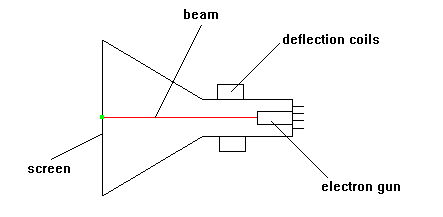NOTES ON MONITORSMany monitors use Cathode Ray Tube (CRT) technology. The inside of the CRT screen has a phosphor coating that glows when struck with high intensity electron beam. Just behind the coating is a metal sheet perforated with thousands of tiny holes. This "shadow mask" defines the resolution of the monitor.... VGA has 640 by 480 pixels. SVGA has 800 by 600 pixels. (A pixel is a picture element or a dot on the monitor image.) The spacing of the holes in the mask determines the degree of image detail pr dot pitch. Normally, the dot pitch ranges from about 0.22 to 0.39 mm; the closer the dots to each other (smaller dot pitch), the greater the image detail.Each of the three CRT guns emit an electron beam which activates the red, green, and blue phosphor dots. The beams scan one horizontal row (raster line) to activate these dots until they reach the end of the screen. At higher screen resolutions, some monitors skip every other row on a pass, scanning the odd numbered rows in one pass, then doing a second pass to scan the even numbered rows.. This type of two pass scanning is called interlacing. Monitors that scan all the raster lines in a single pass are Noninterlaced monitors, and generally produce a better high resolution image than interlaced monitors. The measure of how many horizontal lines the beams can sweep in one second is called the horizontal scan rate or the horizontal frequency and is measured Khz (thousands of cycles per second). The measure of how fast the monitor can draw a full screen from the upper left corner to the lower right corner is called the vertical scanning frequency or the refresh rate and is measured in Hz (cycles per second). A quick way to measure the quality of a monitor is to note the number of controls. Look for at least six… Vertical and horizontal position, vertical and horizontal size, brightness and contrast. From a Cambridge, England Professor
The Cathode Ray Tube (CRT) is used in oscilloscopes,
radar, monitors and television receivers.
At the narrow end are pins which make connection
with an internal ELECTRON GUN.
The face is coated with a PHOSPHOR which
PHOSPHORESCES (glows) when hit by the beam.
Phosphors come in a range of colours. On its way from the gun to the screen the
beam passes between 2 sets of plates.
Note that dropping a CRT causes it to IMPLODE
which is as dangerous as an explosion.
From Sony site............. Question: I have just noticed a thin gray line on the image displayed by my Sony computer monitor. It is about one-third of the way from the bottom of the screen. Is this normal? Answer: This is normal. What you are seeing is the shadow cast by the horizontal damper wire used to stabilize the aperture grille featured on all Sony Trinitron picture tubes. Currently, there are two display technologies designed to isolate individual picture elements (pixels). Together, these pixels form the image displayed on a computer's monitor. Shadow mask technology relies on an opaque sheet with small pinholes to separate pixels both horizontally and vertically. Aperture grille technology employs a series thin, closely-spaced vertical wires to isolate pixels horizontally. The pixels are separated vertically by the nature of the scan lines used to compose the image. There are two main advantages of the aperture
grille method. The most visible is that this method allows more electrons
through, resulting in a brighter image with better contrast. The second
advantage is that the monitor's vertical resolution is not dependent upon,
nor affected by, the vertical spacing of pinholes. A third advantage of
an aperture grille is that it is much less susceptible than a shadow mask
to warping caused by heat. To keep the vertical wires in an aperture grille
properly aligned within the picture tube, one or two horizontal damper
wires are required. A 14-inch or smaller Sony computer monitor employs
one such wire. It is located about one-third of the way from the bottom
of the screen. Sony computer monitors larger than 14 inches use two horizontal
damper wires. These wires are located roughly one-third of the way from
the top and bottom of the screen. Each wire casts a faint shadow that is
visible as a light gray, horizontal line on the image. This shadow is normally
not visible, but may become apparent when displaying a lightly-colored
background.
Question: What is Multiscan Technology? Answer: Multiscan Technology enables
a monitor to self-adjust to video signal from a variety of graphics boards.
This makes it possible to switch between graphic modes without user involvement.
Question: What is difference between Trinitron technology and Shadow Mask technology? Answer: The Trinitron technology
uses an aperture grille. This grille, designed with long, unbroken slits,
allows more light and color to reach the screen, resulting in purer and
more colorful images. The Shadow Mask uses a mesh-like, darker screen that
creates a color shift ("doming") distortion and prevents color purity.
|
